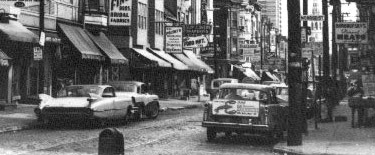| Fourth Street Post World War II |
 |
| photo courtesy of the Philadelphia City Archives |
| Fourth Street Post World War II |
 |
| photo courtesy of the Philadelphia City Archives |
| After the war, life on Fourth
Street changed dramatically. Post-war prosperity meant fulfilling
the American dream of a house in the suburbs. Merchants who had once
lived above their stores now commuted to work. Because of the post-war
building boom, people began buying more home decorative fabrics.
To go along with the trend, many stores shifted their merchandise from
dress fabrics and ready-made curtains to decorative fabrics.
"[Everyone] had new homes and
... enough money, and they wanted everything decorated."
"Most people went into custom-made
-- the heavy draperies with the sheers underneath, wall-to-wall, the whole
works."
"People knew the name 'Silk
Leaders,' so when we went into the drapery business, [we] just never changed
it. People come in here all the time saying, 'Where are your silks?'
"
There was a new level of sophistication on Fourth Street after the war. A few businesses expanded into wholesale as well as retail trade. These included Rosenblitt's ( Roseline Fabrics) and Winitsky & Co. (Win-tex Fabrics). Merchants like Samuel Goldberg went on buying trips around the world. And in the 1950's, pushcarts were outlawed. "[Some] people thought the
end of the world was coming when the pushcarts left...[Instead] it really
lifted the level of customer and sale on the street."
"Fourth Street is still known
all over the United States... You build a reputation."
|
| click arrow to previous page | click arrow to continue |